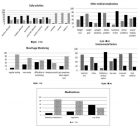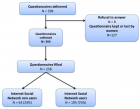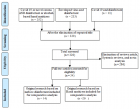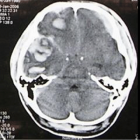Abstract
Mini Review
Mechanism-related Teratogenic, Hormone Modulant and other Toxicological effects of Veterinary and agricultural surfactants
András Székács*
Published: 18 September, 2017 | Volume 1 - Issue 1 | Pages: 024-031
Veterinary and agricultural surfactants are supposed to be inert additives, yet these substances commonly exert biological side-effects, in given cases synergistic with those of the active ingredients of these preparations. This is explicitly seen in altered toxicity of veterinary or pesticide formulations compared to their active ingredients alone. Neither the individual effects of these excipients, nor such combination effects are well-studied in toxicology, and therefore, possible toxicity consequences are occasionally not being considered at sufficient significance in the authorization, use and control of these substances. Risk assessment of these substances should cover all hazards they may represent, and corresponding levels of exposure. Surfactants used in veterinary and pesticide formulation enter the environment either by direct dispersion or by indirect release through excrement, leaching, sewage waters or sludge, and in turn, create potential exposure to a number of non-target organisms. Biochemical and (eco)toxicological hazards recently identified regarding certain agricultural surfactants include cytotoxicity (on cell lines of epithelial, neural and other tissues, as well as stem cells and tumor cells), endocrine disrupting effects, as well as aquatic ecotoxicity. This Mini Review summarizes toxicological effects identified in our studies in aquatic toxicity tests, in cell viability and cytotoxicity tests, in estrogenic activity assays, correlated with biochemical analysis of the surfactants and their decomposition. The conclusions are hoped to facilitate environmentally precautious revision of surfactants widely used in agriculture.
Read Full Article HTML DOI: 10.29328/journal.ivs.1001003 Cite this Article Read Full Article PDF
References
- Castro MJL, Ojeda C, Cirelli AF. Surfactants in Agriculture, Lichtfouse E, Schwarzbauer J & Robert D (Eds.), Springer Verlag, Dordrecht, Green Materials for Energy, Products and Depollution. 2013; 287-334.
- Agricultural Surfactants Market by Type (Anionic, Nonionic, Cationic, and Amphoteric), Applications (Herbicides, Insecticides, Fungicides, and Others), Substrate Type (Synthetic and Bio-based), and by Region - Global Forecasts to 2020, MarketsandMarkets™ Research Private Ltd. 2016.
- Takács E, Klátyik Sz, Mörtl M, Gergely R, Krisztina K, et al. Effects of neonicotinoid insecticide formulations and their components on Daphnia magna-the role of active ingredients and co-formulants. Int J Envorn Anal Chem. 2017; 97: 885-900. Ref.: https://goo.gl/2oRcVU
- Broze G. Detergents: Technical and Practical Challenges, Broze G (Ed.), Marcel Dekker, New York, Handbook of Detergents, Part A: Properties. 1999; 1-4.
- Castro MJL, Ojeda C. Advances in surfactants in agrochemicals. Environ Chem Lett. 2014; 12: 85-89. Ref.: https://goo.gl/Z15r4r
- Cox C, Surgan M. Unidentified inert ingredients in pesticides: implications for human and environmental health. Environ Health Persp. 2006; 114: 1803-1806. Ref.: https://goo.gl/uxy412
- Székács A, Darvas B. Forty Years with Glyphosate. Herbicides-Properties, Synthesis and Control of Weeds. 2012; 247-284. Ref.: https://goo.gl/nMTT1j
- Zoller U. The Survival and Distribution of Alkylphenol Ethoxylate Surfactants in Surface Water and Groundwater, Zoller U (Ed.), CRC Press, Boca Raton, 'Handbook of Detergents, Part B, Environmental Impact (Surfactant Science Series)'. 2004; 467-485.
- Kuster M, Maria López de Alda J, Barceló D. Estrogens and Progestogens in Wastewater, Sludge, Sediments, and Soil. The Handbook of Environmental Chemistry. 2005; 5: 1-24. Ref.: https://goo.gl/QNjT4K
- Hernandez JP, Huang W, Chapman LM, Chua S, Moore DD, et al. The environmental estrogen, nonylphenol, activates the constitutive androstane receptor. Toxicol Sci. 2007; 98: 416-426. Ref.: https://goo.gl/WGmx9S
- Coconut Oil Diethanolamine Condensate. International Agency for Research on Cancer. IARC Monographs. 2011; 101: 141-148.
- Fernández-Ramos C, Ballesteros O, Blanc R, Zafra-Gómez A, Jiménez-Díaz I, et al. Determination of alcohol sulfates in wastewater treatment plant influents and effluents by gas chromatography-mass spectrometry. Talanta. 2012; 98: 166-171. Ref.: https://goo.gl/DbbeFX
- Beneito-Cambra M, Ripoll-Seguer L, Herrero-Martínez JM, Simó-Alfonso EF, Ramis-Ramos G. Determination of fatty alcohol ethoxylates and alkylether sulfates by anionic exchange separation, derivatization with a cyclic anhydride and liquid chromatography. J Chromatogr A. 2011; 1218: 8511-8518. Ref.: https://goo.gl/iSDtUU
- Olkowska E, Polkowska Z, Namieśnik J. Analytical procedures for the determination of surfactants in environmental samples. Talanta. 2012; 88: 1-13. Ref.: https://goo.gl/e2ip3C
- Bergé A, Giroud B, Wiest L, Bruno D, Adriana GO, et al. Development of a multiple-class analytical method based on the use of synthetic matrices for the simultaneous determination of commonly used commercial surfactants in wastewater by liquid chromatography-tandem mass spectrometry. J Chromatogr A. 2016; 1450: 64-75. Ref.: https://goo.gl/ijuCS9
- Tush D, Loftin KA, Meyer MT. Characterization of polyoxyethylene tallow amine surfactants in technical mixtures and glyphosate formulations using ultra-high performance liquid chromatography and triple quadrupole mass spectrometry. J Chromatogr A. 2013; 1319: 80-87. Ref.: https://goo.gl/M4zaiE
- Tush D, Meyer MT. Polyoxyethylene tallow amine, a glyphosate formulation adjuvant: soil adsorption characteristics, degradation profile, and occurrence on selected soils from agricultural fields in Iowa, Illinois, Indiana, Kansas, Mississippi, and Missouri. Environ Sci Technol. 2016; 50: 5781-5789. Ref.: https://goo.gl/Ywnp1z
- Grant RL, Yao C, Gabaldon D, Acosta D. Evaluation of surfactant cytotoxicity potential by primary cultures of ocular tissues: I. Characterization of rabbit corneal epithelial cells and initial injury and delayed toxicity studies. Toxicol. 1992; 76: 153-176. Ref.: https://goo.gl/478MUZ
- Cross J, Singer EJ. Cationic Surfactants: Analytical and Biological Evaluation. CRC Press Boca Raton. 1994; 392.
- Domingo X. A Guide to the Surfactants World. Proa Barcelona. 1995; 286.
- Cavalcante DGSM, Martinez CBR, Sofia SH. Genotoxic effects of Roundup® on the fish Prochilodus lineatus. Mutat Res. 2008; 655: 41-46. Ref.: https://goo.gl/6qUuAu
- Benachour N, Séralini GE. Glyphosate formulations induce apoptosis and necrosis in human umbilical, embryonic, and placental cells. Chem Res Toxicol. 2009; 22: 97-105. Ref.: https://goo.gl/V2y7C9
- Paganelli A, Gnazzo V, Acosta H, López SL, Carrasco AE. Glyphosate-based herbicides produce teratogenic effects on vertebrates by impairing retinoic acid signaling. Chem Res Toxicol. 2010; 23: 1586-1595. Ref.: https://goo.gl/Dk8e9c
- de Menezes CC, da Fonseca MB, Loro VL, Santi A, Cattaneo R, et al. Roundup effects on oxidative stress parameters and recovery pattern of Rhamdia quelen. Arch Environ Contam Toxicol. 2011; 60: 665-671. Ref.: https://goo.gl/7Xy2iL
- Guilherme S, Gaivão I, Santos MA, Pacheco M. DNA damage in fish (Anguilla anguilla) exposed to a glyphosate-based herbicide–elucidation of organ-specificity and the role of oxidative stress. Mutat Res. 2012; 743: 1-9. Ref.: https://goo.gl/fLvVgK
- Pavlic Z, Vidakovic-Cifrek Z, Puntaric D. Toxicity of surfactant to green microalgae Pseudokirchneriella subcapitata and Scenedesmus subspicatus and to marine diatoms Phaeodactylum tricornutum and Skeletonema costatum. Chemosphere. 2005; 61: 1061-1068. Ref.: https://goo.gl/DUyccx
- McLeese DW, Zitko V, Sergeant DB, Burridge L, Metcalfe CD. Lethality and accumulation of alkylphenols in aquatic fauna. Chemosphere. 1981; 10: 723-730. Ref.: https://goo.gl/2FHBkd
- Jobling SJ, Sumpter JP. Detergent components in sewage effluent are weakly oestrogenic to fish: an in vitro study suing rainbow trout hepatocytes. Aquat Toxicol. 1993; 27: 361-372. Ref.: https://goo.gl/d89qiT
- Purdom CE, Hardiman PA, Bye VVJ, Eno NC, Tyler CR, et al. Estrogenic effects from sewage treatment works. Chem Ecol. 1994; 8: 275-285. Ref.: https://goo.gl/pqm9Nj
- Brausch JM, Smith PN. Toxicity of three polyethoxylated tallowamine surfactant formulations to laboratory and field collected fairy shrimp, Thamnocephalus platyurus. Arch Environ Contam Toxicol. 2007; 52: 217-221. Ref.: https://goo.gl/ibfSb1
- Relyea RA. A cocktail of contaminants: how mixtures of pesticides at low concentrations affect aquatic communities. Oecologia. 2009; 159: 363-376. Ref.: https://goo.gl/y5fGBG
- Piggott JJ, Townsend CR, Matthaei CD. Reconceptualizing synergism and antagonism among multiple stressors. Ecol Evol. 2015; 5: 1538-1547. Ref.: https://goo.gl/26t1C2
- Rulison C. Synergistic Aspects of Surfactant Mixtures. I. The Anionic Surfactant Sodium Dodecyl Sulfate and the Cationic Surfactant Trimethylammonium Bromide. Krüss Laboratory Services and Instrumentation for Surface Science. 2012; 1-23. Ref.: https://goo.gl/NZrmZG
- Azum N, Alamry KA, Khan SB, Malik Abdul Rub, Abdullah Asiri M, et al. Synergistic interaction between anionic and nonionic surfactant: Application of the mixed micelles templates for the synthesis of silver nanoparticles. Int J Electrochem Sci. 2016; 11: 1852-1867. Ref.: https://goo.gl/8cWA8m
- Hay PM. Synergistic interactions of shampoo ingredients. J Amer Oil Chem Soc. 1972; 49: 343-345. Ref.: https://goo.gl/R1qqyH
- Shao Z, Li Y, Krishnamoorty R, Chermak T, Mitra AK. Differential effects of anionic, cationic, nonionic, and physiologic surfactants on the dissociation, alpha-chymotryptic degradation, and enteral absorption of insulin hexamers. Pharm Res. 1993; 10: 243-251. Ref.: https://goo.gl/QWHDFS
- OECD (Organisation for Economic Co-operation and Development). Test No. 202: Daphnia sp. Acute Immobilisation Test. OECD Publishing. 2004; 1-16.
- OECD (Organisation for Economic Co-operation and Development). Test No. 211: Daphnia magna Reproduction Test. OECD Publishing. 2012; 1-25.
- ISO (International Organization for Standardization). ISO 6341. Water Quality-Determination of the Inhibition of the Mobility of Daphnia magna Straus (Cladocera, Crustacea) - Acute Toxicity Test. International Organization for Standardization. 2012; 1-22.
- Mesnage R, Defarge N, de Vendômois JS, Séralini GE. Major pesticides are more toxic to human cells than their declared active principles. Biomed Res Int. 2014; 2014: 1-8. Ref.: https://goo.gl/x6PPih
- Effects of Surfactants on the Toxicity of Glyphosate, with Specific Reference to RODEO. US Environmental Protection Agency. 1997; 1-28.
- Tsui MT, Chu LM. Aquatic toxicity of glyphosate-based formulations: comparison between different organisms and the effects of environmental factors.Chemosphere. 2003; 52: 1189-1197. Ref.: https://goo.gl/cbVZYT
- Székács A, Mörtl M, Fekete G, Ágnes F, Béla D, et al. Monitoring and biological evaluation of surface water and soil micropollutants in Hungary. Carpathian J Earth Environ Sci. 2014; 9: 47-60. Ref.: https://goo.gl/ePkhAk
- Klátyik SZ, Takács E, Mörtl M, et al. Dissipation of the herbicide active ingredient glyphosate in natural water samples in the presence of biofilms. Int J Envir Anal Chem. 2017; 97.
- Székács I, Fejes Á, Klátyik Sz, Takács E, Patkó Dániel, et al. Environmental and toxicological impacts of glyphosate with its formulating adjuvant. Int J Biol Biomol Agric Food Biotech Eng. 2014; 8: 219-224. Ref.: https://goo.gl/PbXraK
- OECD (Organisation for Economic Co-operation and Development). Test No. 236: Fish Embryo Acute Toxicity (FET) Test. OECD. 2013; 1-22.
- Ottucsák M, Klátyik Sz, Gyurcsó G, et al. Environmental Monitoring of Glyphosate and Assessment of its Combined Cytotoxicity with Adjuvants. Proc 21st International Symposium on Analytical and Environmental Problems. 2015; 64-67.
- Székács I, Horvath R, Székács A. Label-Free Optical Biosensors for Monitoring Cellular Processes and Cytotoxic Agents at Interfaces Using Guided Modes and Advanced Phase-Contrast Imaging Techniques. Biosensors for Security and Bioterrorism Applications. 2016; 443-468. Ref.: https://goo.gl/qNBLLL
- Kotlan B, Liszkay G, Csuka O, et al. Reduced tumor-associated glycosphingolipides in cell membrane lipid rafts and a diminished proliferation rate in mammary breast carcinoma cultures after incubation with glyphosate-based formulations. 32nd Annual Meeting of the Society for Immunotherapy of Cancer. 2017; in press.
- Defarge N, Takács E, Lozano VL, Mesnage R, Spiroux de Vendômois J, et al. Co-formulants in glyphosate-based herbicides disrupt aromatase activity in human cells below Toxic levels. Int J Environ Res Public Health. 2016; 13: 1-17. Ref.: https://goo.gl/2R9zdg
- Klátyik Sz, Bohus P, Darvas B, Székács A. Authorization and toxicity of veterinary drugs and plant protection products: residues of the active ingredients in food and feed and toxicity problems related to adjuvants. Front Vet Sci. 2017; 4: 1-21. Ref.: https://goo.gl/7krms4
Similar Articles
-
Exploring novel medical applications for commonly used veterinary drug (tilmicosin antibiotic)Fatma I Abo El-Ela*,El-Banna HA. Exploring novel medical applications for commonly used veterinary drug (tilmicosin antibiotic). . 2017 doi: 10.29328/journal.ivs.1001001; 1: 001-016
-
Investigation on Theileria lestoquardi infection among sheep and goats in Nyala, South Darfur State, SudanOsman TM,Ali AM*,Hussein MO,El Ghali A,Salih DA. Investigation on Theileria lestoquardi infection among sheep and goats in Nyala, South Darfur State, Sudan. . 2017 doi: 10.29328/journal.ivs.1001002; 1: 017-023
-
Mechanism-related Teratogenic, Hormone Modulant and other Toxicological effects of Veterinary and agricultural surfactantsAndrás Székács*. Mechanism-related Teratogenic, Hormone Modulant and other Toxicological effects of Veterinary and agricultural surfactants. . 2017 doi: 10.29328/journal.ivs.1001003; 1: 024-031
-
Efficacies of 11% Lactoferricin and 0.05% Chlorhexidine Otological Solution compared, in the treatment of microbial otic overgrowth: A randomized single blinded studyLuisa Cornegliani*,Federico Leone,Francesco Albanese,Mauro Bigliati,Natalia Fanton,Antonella Vercelli. Efficacies of 11% Lactoferricin and 0.05% Chlorhexidine Otological Solution compared, in the treatment of microbial otic overgrowth: A randomized single blinded study. . 2017 doi: 10.29328/journal.ivs.1001004; 1: 032-041
-
Ocular surface Rose Bengal staining in normal dogs and dogs with Keratoconjunctivitis Sicca: Preliminary findingsWilliams DL*,Griffiths A. Ocular surface Rose Bengal staining in normal dogs and dogs with Keratoconjunctivitis Sicca: Preliminary findings. . 2017 doi: 10.29328/journal.ivs.1001005; 1: 042-046
-
Influence of Vitamin E on the Disposition Kinetics of Florfenicol after single and multiple oral administrations in Broiler ChickensFatma Ibrahim Abo El-Ela*,Hossny Awad El-Banna,Manal B El-Deen,Tohamy MA. Influence of Vitamin E on the Disposition Kinetics of Florfenicol after single and multiple oral administrations in Broiler Chickens. . 2017 doi: 10.29328/journal.ivs.1001006; 1: 047-057
-
Effects of carazolol on electrocadiographic and trace element status in sheepsRemzi Gonul,Lora Koenhemsı,Handan Aydın Vural*,Tevfik Gulyasar,Hasret Demırcan Yardıbı,Erman OR,Bora Barutcu. Effects of carazolol on electrocadiographic and trace element status in sheeps. . 2018 doi: 10.29328/journal.ivs.1001007; 2: 001-004
-
Livestock insurance a tool to reduce economical loss of farmers from climate change related HazardsAnanta Koirala*,Priyanka Bhandari. Livestock insurance a tool to reduce economical loss of farmers from climate change related Hazards. . 2018 doi: 10.29328/journal.ivs.1001008; 2: 005-008
-
The failure to provide an effective veterinary service to sheep in AustraliaJAL Maxwell*. The failure to provide an effective veterinary service to sheep in Australia. . 2018 doi: 10.29328/journal.ivs.1001009; 2: 009-017
-
Does Veterinary Science have a future in Australia?JAL Maxwell*. Does Veterinary Science have a future in Australia?. . 2018 doi: 10.29328/journal.ivs.1001010; 2: 018-026
Recently Viewed
-
Pulmonary Infarction Mimicking An Aspergilloma In A Heart Transplant RecipientAntonacci F*,Belliato M,Bortolotto C,Di Perna D,Dore R,Orlandoni G,D’Armini AM. Pulmonary Infarction Mimicking An Aspergilloma In A Heart Transplant Recipient . J Clin Med Exp Images. 2017: doi: 10.29328/journal.jcmei.1001002; 1: 005-006
-
Recurrent Peripheral Ameloblastoma of the Mandible: A Case ReportAngela Jordão Camargo*,Mayara Cheade,Celso Martinelli,Plauto Christopher Aranha Watanabe. Recurrent Peripheral Ameloblastoma of the Mandible: A Case Report. J Clin Med Exp Images. 2017: doi: 10.29328/journal.jcmei.1001003; 1: 007-010
-
The Risk Factors for Ankle Sprain in Cadets at a Male Military School in Iran: A Retrospective Case-control StudyFarzad Najafipour*,Farshad Najafipour,Mohammad Hassan Majlesi,Milad Darejeh. The Risk Factors for Ankle Sprain in Cadets at a Male Military School in Iran: A Retrospective Case-control Study. J Clin Med Exp Images. 2017: doi: 10.29328/journal.jcmei.1001005; 1: 020-026
-
Magnetic Resonance Imaging Can Detect Symptomatic Patients with Facet Joint Pain. A Retrospective AnalysisWolfgang Freund*,Frank Weber,Reinhard Meier,Stephan Klessinger. Magnetic Resonance Imaging Can Detect Symptomatic Patients with Facet Joint Pain. A Retrospective Analysis. J Clin Med Exp Images. 2017: doi: 10.29328/journal.jcmei.1001006; 1: 027-036
-
Secondary Onychomycosis Development after Cosmetic Procedure-Case ReportMariusz Dyląg*,Emilia Flisowska,Patryk Bielecki,Maria Kozioł-Gałczyńska,Weronika Jasińska. Secondary Onychomycosis Development after Cosmetic Procedure-Case Report . J Clin Med Exp Images. 2017: doi: 10.29328/journal.jcmei.1001007; 1: 037-045
Most Viewed
-
Impact of Latex Sensitization on Asthma and Rhinitis Progression: A Study at Abidjan-Cocody University Hospital - Côte d’Ivoire (Progression of Asthma and Rhinitis related to Latex Sensitization)Dasse Sery Romuald*, KL Siransy, N Koffi, RO Yeboah, EK Nguessan, HA Adou, VP Goran-Kouacou, AU Assi, JY Seri, S Moussa, D Oura, CL Memel, H Koya, E Atoukoula. Impact of Latex Sensitization on Asthma and Rhinitis Progression: A Study at Abidjan-Cocody University Hospital - Côte d’Ivoire (Progression of Asthma and Rhinitis related to Latex Sensitization). Arch Asthma Allergy Immunol. 2024 doi: 10.29328/journal.aaai.1001035; 8: 007-012
-
Causal Link between Human Blood Metabolites and Asthma: An Investigation Using Mendelian RandomizationYong-Qing Zhu, Xiao-Yan Meng, Jing-Hua Yang*. Causal Link between Human Blood Metabolites and Asthma: An Investigation Using Mendelian Randomization. Arch Asthma Allergy Immunol. 2023 doi: 10.29328/journal.aaai.1001032; 7: 012-022
-
An algorithm to safely manage oral food challenge in an office-based setting for children with multiple food allergiesNathalie Cottel,Aïcha Dieme,Véronique Orcel,Yannick Chantran,Mélisande Bourgoin-Heck,Jocelyne Just. An algorithm to safely manage oral food challenge in an office-based setting for children with multiple food allergies. Arch Asthma Allergy Immunol. 2021 doi: 10.29328/journal.aaai.1001027; 5: 030-037
-
Snow white: an allergic girl?Oreste Vittore Brenna*. Snow white: an allergic girl?. Arch Asthma Allergy Immunol. 2022 doi: 10.29328/journal.aaai.1001029; 6: 001-002
-
Cytokine intoxication as a model of cell apoptosis and predict of schizophrenia - like affective disordersElena Viktorovna Drozdova*. Cytokine intoxication as a model of cell apoptosis and predict of schizophrenia - like affective disorders. Arch Asthma Allergy Immunol. 2021 doi: 10.29328/journal.aaai.1001028; 5: 038-040

If you are already a member of our network and need to keep track of any developments regarding a question you have already submitted, click "take me to my Query."

















































































































































